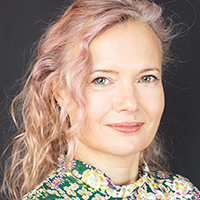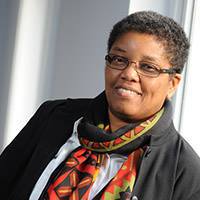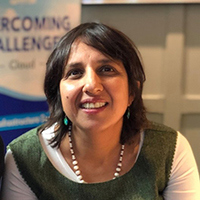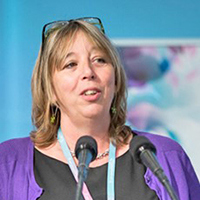There are myriad reasons why women choose not to pursue a career in STEM - but what can be done to change this? Johanna Hamilton AMBCS and Blair Melsom MBCS speak to some of the most influential women in tech for their advice.
There is a long history of ‘hidden women’ in science, technologists, mathematicians and engineers all working on projects of international importance, such as the moon landings in the 1960s or wartime codebreaking, and the development of the first computers.
Female problem solving and invention has seen the creation of Kevlar, the dishwasher, windscreen wipers, and the child-safe plug, and yet for social and cultural reasons, the achievements of women, of 52% of the population, remain largely unacknowledged.
It’s the 21st century - how can we fix this for future generations?
1. Be more attractive to women
 ‘If there was a simple way of getting more women in tech the gender imbalance would already be fixed. It’s tempting to blame the pipeline yet many senior people in tech did not start out their careers as programmers and often move into senior roles through a sidestep, so whilst I agree the pipeline needs to be addressed I don’t buy it as a valid reason for the lack of women in tech.
‘If there was a simple way of getting more women in tech the gender imbalance would already be fixed. It’s tempting to blame the pipeline yet many senior people in tech did not start out their careers as programmers and often move into senior roles through a sidestep, so whilst I agree the pipeline needs to be addressed I don’t buy it as a valid reason for the lack of women in tech.
‘Organisations need to, and can, do better at attracting women to apply for roles and certainly can do far better at choosing to hire women. We still live in a world where hiring a woman is unconsciously perceived as a risk , because that woman won’t be the same as what’s gone before, her ‘face won’t fit’ so readily.
‘Hiring anyone into a role is a risk - it’s somewhat ridiculous to attach more risk to someone because the hiring managers haven’t previously worked with a woman in that type of job. Saying ‘women just don’t apply for these roles’ is a cop-out - the responsibility for fixing that sits with the hiring organisation.’
Mivy James FBCS, Digital Transformation Director at BAE Systems Applied Intelligence.
2. Create a more inclusive culture
 ‘The percentage of women in technology is 16%, with little growth in 10 years. Much has been said about the ‘dirty’ image of engineering. Nothing could be further removed from the truth especially computing.
‘The percentage of women in technology is 16%, with little growth in 10 years. Much has been said about the ‘dirty’ image of engineering. Nothing could be further removed from the truth especially computing.
‘Another misconception about technology is that it’s for ‘geeks’. Perhaps some work needs to be done here to dispel this idea? The more women are seen in these roles the quicker this image can be dispelled.
‘However, there is what is known as the leaky pipeline, women leave the profession in greater numbers. The focus should be on understanding why this happens and seeking to improve retention.’
Dorothy Monekosso HonFBCS, Professor of Computer Science at Leeds Beckett University, and the recipient of an honorary fellowship at BCS.
3. Look for easy wins
 ‘We can get more females by initially identifying opportunities that females can also partake in. This can be obtained by ensuring that there is a network of individuals (both females and males) who can identify, raise awareness and recruit the best possible candidate that can be a female.
‘We can get more females by initially identifying opportunities that females can also partake in. This can be obtained by ensuring that there is a network of individuals (both females and males) who can identify, raise awareness and recruit the best possible candidate that can be a female.
'Also, we need to have more funding opportunities that females can participate in, or to have mentors who can ensure that there will be an avenue for women to enter and succeed in the technology sector. In social media, classic media channels like, TV, or radio, to also ensure that comments are provided by leading females in the technology sector.'
Jyoti Choudrie FBCS, Professor of Information Systems at the University of Hertfordshire.
4. Be yourself, your authentic self
 ‘There are a number of initiatives we must undertake. Some organisations create ‘aspirational’ targets and quotas. This can, in some cases be controversial, but it does create a mindset change and draws attention to the fundamental problem of a lack of women in tech roles.
‘There are a number of initiatives we must undertake. Some organisations create ‘aspirational’ targets and quotas. This can, in some cases be controversial, but it does create a mindset change and draws attention to the fundamental problem of a lack of women in tech roles.
‘One initiative to consider is encouraging women working in the tech industry to be visible tech role models. This visibility will allow connections and networking with other women thinking of entering the industry - through helping, encouraging and sharing experiences.
‘Secondly, coaching and mentoring by women working in tech roles is super important to ensure a strong sustainable pipeline of female talent. To further build a greater talent pool, organisations should encourage more coding clubs for girls which can raise awareness to the creative, analytical and solution building skills coding brings and the many job areas you can move into.
‘Finally, we need leaders, more male allies and advocates who fully understand why we need greater gender equality in the tech industry. We need these people to get onboard and be visible and vocal supporters for the encouragement for more women in tech.’
Rubi Kaur FBCS, Senior Solutions Architect at Vodafone.
5. Get the men on-side
 ‘We must build expectations for young women that a tech career can be relevant for them, and they can succeed in it. Role models matter! But this is a cultural change, and not something we only need change for girls. Boys and parents equally need to believe that girls belong in tech.
‘We must build expectations for young women that a tech career can be relevant for them, and they can succeed in it. Role models matter! But this is a cultural change, and not something we only need change for girls. Boys and parents equally need to believe that girls belong in tech.
‘Beyond this, we need to ensure women in tech thrive in their careers. It’s a career I love, but unfortunately, we see women disproportionally leaving the tech workforce, and failing to progress at the same rate as men. We will only increase representation of women in tech if we also strive to increase retention and development of the women we already have.’
Jo Stansfield MBCS, founder and director of Inclusioneering and IT thought leader.
6. Become an #ImmodestWomen
 ‘The study of science was not considered respectable for girls of my generation. But it’s always good to challenge damaging stereotypes. Blatant sexism may be illegal and much has disappeared following legislation.
‘The study of science was not considered respectable for girls of my generation. But it’s always good to challenge damaging stereotypes. Blatant sexism may be illegal and much has disappeared following legislation.
‘Today the issues are cultural - which are much more difficult to address. But there remains huge potential for prejudice against girls. Both men and women use the same stereotypes. It’s important to offset that unconscious bias that everyone, every single person has.
‘I want our girls to aim high, knowing they are more than competent in tech and hankering to do the top jobs.’
Dame Stephanie Shirley CH FBCS, pioneering IT entrepreneur and passionate philanthropist.
7. Emphasise the force for good
 It’s a chicken and egg situation. Tech looks masculine in many ways because it was predominantly designed, consciously and unconsciously, by and for men. Several others have referred to Invisible Women by Caroline Criado-Perez for evidence of how this systematically disadvantages women in all walks of life. We need more talent, but we also need to ensure that the systems of our society support all of society’s members.
It’s a chicken and egg situation. Tech looks masculine in many ways because it was predominantly designed, consciously and unconsciously, by and for men. Several others have referred to Invisible Women by Caroline Criado-Perez for evidence of how this systematically disadvantages women in all walks of life. We need more talent, but we also need to ensure that the systems of our society support all of society’s members.
The big thought I always try to get over when speaking to girls and young women about careers in tech is how much of a force multiplier for good it is. You can only help a few individuals at a time in face-to-face roles, but a good algorithm or device can improve the lives of millions.
Professor Penny Endersby, Met Office Chief Executive.
8. Help shape the tech that shapes the future
 I asked a class of key stage 3 girls why virtual assistants such as Alexa were pre-programmed with female voices. In return, everyone in that class gave me animated answers, eloquently explaining the perceived role of women in history, the lack of women in designing technology and ingrained biases that lead to such product design choices. When I followed up and asked who in that room intended to solve this problem, not one hand went up.
I asked a class of key stage 3 girls why virtual assistants such as Alexa were pre-programmed with female voices. In return, everyone in that class gave me animated answers, eloquently explaining the perceived role of women in history, the lack of women in designing technology and ingrained biases that lead to such product design choices. When I followed up and asked who in that room intended to solve this problem, not one hand went up.
We understand the problems caused when women are not designing new products. We know it is economically detrimental to the organisation and society. We know what caused these issues in the first place.
Our role now is to change this and inspire young people of all genders to shape technology, in order to shape their future. We need to ensure they find a safe and exciting workplace where they can be innovative and thrive.
Kavita Kapoor FBCS, Senior Lecturer in Product Management for Emerging Technology, CODE University.
9. Know that your views matter: get involved to make sure they’re heard
 In today’s world, there are very few who do not spend a large majority of their time interacting with tech in some form or other. Even if you live in the furthest corners of the country, you probably have an internet-connected mobile phone, use one or more streaming services and have online banking.
In today’s world, there are very few who do not spend a large majority of their time interacting with tech in some form or other. Even if you live in the furthest corners of the country, you probably have an internet-connected mobile phone, use one or more streaming services and have online banking.
In the UK, females make up just over 50% of the population, but this figure is not currently represented in the teams that are designing, building and testing our everyday technology. We need more women joining the tech industry to add their viewpoints and thought processes to the creation and development of IT. Addressing the current gender imbalance will not only benefit the companies building IT solutions but also the wider society that will engage with them.
Rachel Steenson FBCS, Business Development Manager at CIVICA.
10. Why should the guys get all the great jobs?
 We know diverse teams perform better, because it helps to have different perspectives feeding into the decision-making process. However, we also know that people are more likely to stay in careers when they feel they belong and at the moment, many women in tech feel like the odd one out.
We know diverse teams perform better, because it helps to have different perspectives feeding into the decision-making process. However, we also know that people are more likely to stay in careers when they feel they belong and at the moment, many women in tech feel like the odd one out.
We need more women in tech because it's a bit strange being the only woman in a room. If there were more of us, this wouldn't happen quite as often.
We need more women in tech because it's annoying being mistaken for the salesperson or the PA.
We need it to be normal for there to be women in boardrooms, at conferences, building stuff and fixing stuff.
We need more women in tech because tech careers can be rewarding, fulfilling and well-paid, and why should the guys get all the great jobs?
If we build more diverse teams, we can improve things and help retain the women who are already in tech.
Dr Hannah Dee MBCS, Senior Lecturer in Computer Science, Aberystwyth University.
11. Change the culture
 For far too long, our industry has been dominated by one gender (just a pointer: there aren’t many women!). The implications of this imbalance are far reaching. Where there is a dominant class, gender or race, they get to make the decisions, they choose who is approved and who is doubted, and they select the leaders and ‘winners’ to stand beside them.
For far too long, our industry has been dominated by one gender (just a pointer: there aren’t many women!). The implications of this imbalance are far reaching. Where there is a dominant class, gender or race, they get to make the decisions, they choose who is approved and who is doubted, and they select the leaders and ‘winners’ to stand beside them.
For the workplace culture, the imbalance can be damaging. It fails to respect the needs and wishes of all and creates a privileged majority who dominate decision making. Those who are in the minority groups, whether by gender, race, age, or by their intersectionality, can become overlooked, unwanted, stuck behind glass ceilings, frustrated, unconfident and ready to leave. It is worth considering how that impacts the pervasive culture within a workplace.
With a disparity of privilege in the office, some feeling left out, some feeling dominant, we have a really fertile space for discontent. Imagine how it would be if we were much more equally matched in gender and race and age and ability. If what we saw around us regularly reminded us of the valuable mix we have in society.
Someone once told me how it had been when their almost 100% female workforce was merged with a male-dominated workforce through acquisition. They said that when the new organisation got to 50:50, it had been a fantastic, fun and vibrant place to work. Now how nice would that be!
Gillian Arnold FBCS, Managing Director at Tectre Ltd.
12. Know that the world needs technologies that reflect the needs of half of its inhabitants
Technology is both an enabler and a blocker of systemic change. As women make up half of the population on the planet, it should no longer be necessary to make the case for more of us in technology; rather, it should now be the norm that women are embedded in every aspect of its evolution.
With every campaign and programme to encourage more girls and women into technology (and other science, engineering and mathematics fields), it is a reminder that the system still requires transformation and deeper shifts.
With every crisis, conflict and tragedy, there is a need for women and our allies to lead and participate in the solutions that affect our own lives and those of our loved ones. International Women's Day 2022 is a call to action for all to actively support education, develop new career routes, reform workplace policies, enable meaningful part time roles, fund specialist training, take time to mentor and coach, support returners and progression through succession planning... break down the barriers that stop half of the world from participating in its evolution.
Tristi Tanaka MBCS, Head of the CMO Office, Black Country and West Birmingham CCG.












